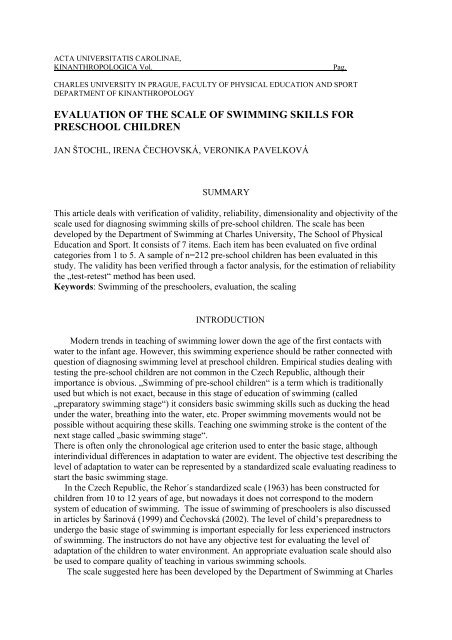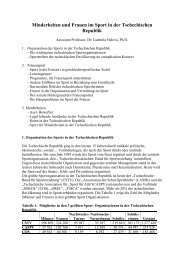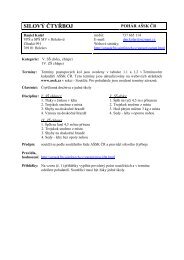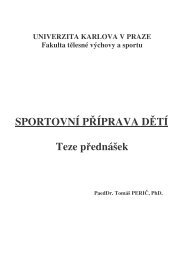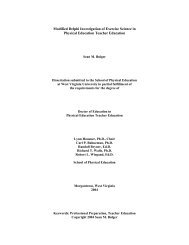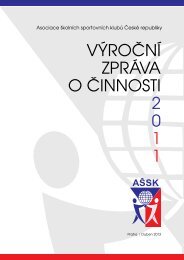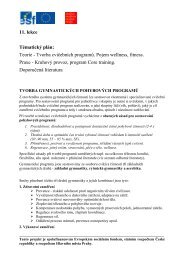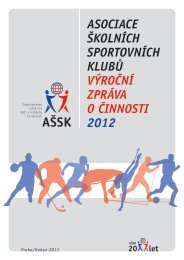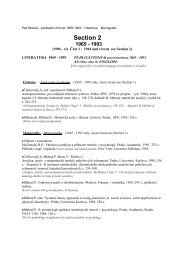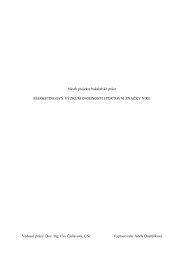evaluation of the scale of swimming skills for preschool children
evaluation of the scale of swimming skills for preschool children
evaluation of the scale of swimming skills for preschool children
You also want an ePaper? Increase the reach of your titles
YUMPU automatically turns print PDFs into web optimized ePapers that Google loves.
ACTA UNIVERSITATIS CAROLINAE,<br />
KINANTHROPOLOGICA Vol. Pag.<br />
CHARLES UNIVERSITY IN PRAGUE, FACULTY OF PHYSICAL EDUCATION AND SPORT<br />
DEPARTMENT OF KINANTHROPOLOGY<br />
EVALUATION OF THE SCALE OF SWIMMING SKILLS FOR<br />
PRESCHOOL CHILDREN<br />
JAN ŠTOCHL, IRENA ČECHOVSKÁ, VERONIKA PAVELKOVÁ<br />
SUMMARY<br />
This article deals with verification <strong>of</strong> validity, reliability, dimensionality and objectivity <strong>of</strong> <strong>the</strong><br />
<strong>scale</strong> used <strong>for</strong> diagnosing <strong>swimming</strong> <strong>skills</strong> <strong>of</strong> pre-school <strong>children</strong>. The <strong>scale</strong> has been<br />
developed by <strong>the</strong> Department <strong>of</strong> Swimming at Charles University, The School <strong>of</strong> Physical<br />
Education and Sport. It consists <strong>of</strong> 7 items. Each item has been evaluated on five ordinal<br />
categories from 1 to 5. A sample <strong>of</strong> n=212 pre-school <strong>children</strong> has been evaluated in this<br />
study. The validity has been verified through a factor analysis, <strong>for</strong> <strong>the</strong> estimation <strong>of</strong> reliability<br />
<strong>the</strong> „test-retest“ method has been used.<br />
Keywords: Swimming <strong>of</strong> <strong>the</strong> <strong>preschool</strong>ers, <strong>evaluation</strong>, <strong>the</strong> scaling<br />
INTRODUCTION<br />
Modern trends in teaching <strong>of</strong> <strong>swimming</strong> lower down <strong>the</strong> age <strong>of</strong> <strong>the</strong> first contacts with<br />
water to <strong>the</strong> infant age. However, this <strong>swimming</strong> experience should be ra<strong>the</strong>r connected with<br />
question <strong>of</strong> diagnosing <strong>swimming</strong> level at <strong>preschool</strong> <strong>children</strong>. Empirical studies dealing with<br />
testing <strong>the</strong> pre-school <strong>children</strong> are not common in <strong>the</strong> Czech Republic, although <strong>the</strong>ir<br />
importance is obvious. „Swimming <strong>of</strong> pre-school <strong>children</strong>“ is a term which is traditionally<br />
used but which is not exact, because in this stage <strong>of</strong> education <strong>of</strong> <strong>swimming</strong> (called<br />
„preparatory <strong>swimming</strong> stage“) it considers basic <strong>swimming</strong> <strong>skills</strong> such as ducking <strong>the</strong> head<br />
under <strong>the</strong> water, breathing into <strong>the</strong> water, etc. Proper <strong>swimming</strong> movements would not be<br />
possible without acquiring <strong>the</strong>se <strong>skills</strong>. Teaching one <strong>swimming</strong> stroke is <strong>the</strong> content <strong>of</strong> <strong>the</strong><br />
next stage called „basic <strong>swimming</strong> stage“.<br />
There is <strong>of</strong>ten only <strong>the</strong> chronological age criterion used to enter <strong>the</strong> basic stage, although<br />
interindividual differences in adaptation to water are evident. The objective test describing <strong>the</strong><br />
level <strong>of</strong> adaptation to water can be represented by a standardized <strong>scale</strong> evaluating readiness to<br />
start <strong>the</strong> basic <strong>swimming</strong> stage.<br />
In <strong>the</strong> Czech Republic, <strong>the</strong> Rehor´s standardized <strong>scale</strong> (1963) has been constructed <strong>for</strong><br />
<strong>children</strong> from 10 to 12 years <strong>of</strong> age, but nowadays it does not correspond to <strong>the</strong> modern<br />
system <strong>of</strong> education <strong>of</strong> <strong>swimming</strong>. The issue <strong>of</strong> <strong>swimming</strong> <strong>of</strong> <strong>preschool</strong>ers is also discussed<br />
in articles by Šarinová (1999) and Čechovská (2002). The level <strong>of</strong> child’s preparedness to<br />
undergo <strong>the</strong> basic stage <strong>of</strong> <strong>swimming</strong> is important especially <strong>for</strong> less experienced instructors<br />
<strong>of</strong> <strong>swimming</strong>. The instructors do not have any objective test <strong>for</strong> evaluating <strong>the</strong> level <strong>of</strong><br />
adaptation <strong>of</strong> <strong>the</strong> <strong>children</strong> to water environment. An appropriate <strong>evaluation</strong> <strong>scale</strong> should also<br />
be used to compare quality <strong>of</strong> teaching in various <strong>swimming</strong> schools.<br />
The <strong>scale</strong> suggested here has been developed by <strong>the</strong> Department <strong>of</strong> Swimming at Charles
University, The Faculty <strong>of</strong> Physical Education and Sport. It consists <strong>of</strong> seven following items.<br />
Each item is quantified on ordinary <strong>scale</strong> from 1 to 5 levels – categories (see Appendix).<br />
1) Head ducking<br />
2) Floating on front side <strong>of</strong> <strong>the</strong> body<br />
3) Floating on back side <strong>of</strong> <strong>the</strong> body<br />
4) Breathing into <strong>the</strong> water<br />
5) Diving<br />
6) Fishing out two objects<br />
7) Rotation around <strong>the</strong> lengthwise axis<br />
METHODS<br />
The research sample consisted <strong>of</strong> n=212 <strong>preschool</strong> <strong>children</strong> from 4 to 6 years old. This sample<br />
has not been supposed to be random but still represented a typical picture <strong>of</strong> Prague<br />
<strong>preschool</strong>ers and kindergarden <strong>children</strong>. The research has been organised in two phases. At<br />
first, <strong>the</strong> subsample <strong>of</strong> <strong>swimming</strong> experienced <strong>children</strong> has been tested. This sample contents<br />
101 <strong>children</strong> from various nurseries from Prague, who have benn attended <strong>the</strong> Swimming<br />
School <strong>of</strong> <strong>the</strong> Slavia sport club in Prague on a regular, once a week and who have gone<br />
through 28 lessons <strong>of</strong> prep-stage <strong>of</strong> education <strong>of</strong> <strong>swimming</strong> be<strong>for</strong>e being tested. In <strong>the</strong> 30th<br />
lesson a retest has been applied. In <strong>the</strong> second phase <strong>of</strong> <strong>the</strong> research <strong>the</strong> subsample <strong>of</strong> <strong>the</strong><br />
beginners has been tested. This sample <strong>of</strong> beginners has been consisted <strong>of</strong> 111 <strong>children</strong> who<br />
completed 4 lessons <strong>of</strong> <strong>the</strong> education <strong>of</strong> pre-<strong>swimming</strong>. The retest has been carried out in <strong>the</strong><br />
6th lesson. The time interval between <strong>the</strong> test and <strong>the</strong> retest has been two weeks. The sample<br />
<strong>of</strong> beginners has been contamined by some <strong>children</strong> with <strong>swimming</strong> experience, but it has<br />
been impossible to identify <strong>the</strong>m.<br />
Three independent raters have been carried out <strong>the</strong> <strong>scale</strong>. They all have been assessed one<br />
child at <strong>the</strong> same time.<br />
For standardization <strong>of</strong> <strong>the</strong> <strong>scale</strong> following methods have been used:<br />
• To obtain <strong>the</strong> data, we chose <strong>the</strong> method <strong>of</strong> <strong>scale</strong> observation.<br />
• To evaluate dimensionality and construct validity we used a confirmatory factor<br />
analysis, (GFI = Bentler´s delta and Root Mean Square Residual coefficient)<br />
• To estimate a reliability <strong>of</strong> <strong>the</strong> <strong>scale</strong> a test-retest method (stability in time) has been<br />
used.<br />
• To state <strong>the</strong> objectivity (inter-rater reliability) <strong>of</strong> <strong>the</strong> <strong>scale</strong> a method <strong>of</strong> inter-rater<br />
agreement (through intraclass correlation coefficient) has been applied.<br />
S<strong>of</strong>tware used in this study: NCSS (correlations, descriptive statistics), SPSS (intraclass<br />
correlation coefficient), GEFA (factor analysis)<br />
HYPOTHESIS<br />
In <strong>the</strong> general basis outlined above and usual experience and findings, we assume:<br />
• Objectivity coefficient will be higher than 0.9<br />
• Dimensionality <strong>of</strong> <strong>the</strong> <strong>scale</strong> will be higher than 1.<br />
• The items such as „Head ducking“ and „Breathing into <strong>the</strong> water“ will be highly<br />
correlated<br />
• Estimations <strong>of</strong> coefficients <strong>of</strong> <strong>the</strong> construct validity in relation to <strong>the</strong> concept „level <strong>of</strong><br />
adaptation on water environment“ criteria will be higher than 0.8.
RESULTS<br />
Dimensionality <strong>of</strong> <strong>the</strong> <strong>scale</strong><br />
Dimensionality has been verified by GEFA. With regard to <strong>the</strong> structure <strong>of</strong> correlation<br />
submatrices <strong>of</strong> each rater it has been tested <strong>the</strong> hypo<strong>the</strong>sis <strong>of</strong> unidimensionality <strong>of</strong> <strong>the</strong> <strong>scale</strong>.<br />
Following three matrices (from table 1 to table 3) have been tested.<br />
Table 1 Correlation matrix – Rater 1<br />
Ducking Front Back BreathingDiving Fishing Ducking<br />
Rotation<br />
out<br />
1,00<br />
Front 0,65 1,00<br />
Back 0,54 0,71 1,00<br />
Breathing 0,75 0,70 0,66 1,00<br />
Diving 0,63 0,64 0,59 0,65 1,00<br />
Fishing out 0,57 0,65 0,59 0,66 0,64 1,00<br />
Rotation 0,57 0,70 0,71 0,63 0,66 0,73 1,00<br />
Table 2 Correlation matrix - Rater 2<br />
Ducking Front Back BreathingDiving Fishing<br />
out Rotation<br />
Ducking 1,00<br />
Front<br />
0,66 1,00<br />
Back 0,55 0,75 1,00<br />
Breathing 0,71 0,67 0,61 1,00<br />
Diving 0,58 0,66 0,58 0,64 1,00<br />
Fishing out 0,65 0,72 0,64 0,72 0,70 1,00<br />
Rotation 0,53 0,73 0,71 0,61 0,67 0,77 1,00<br />
Table 3 Correlation matrix – Rater 3<br />
Ducking Front Back BreathingDiving Fishing<br />
out Rotation<br />
Ducking 1,00<br />
Front<br />
0,64 1,00<br />
Back 0,57 0,75 1,00<br />
Breathing 0,71 0,67 0,67 1,00<br />
Diving 0,62 0,66 0,63 0,65 1,00<br />
Fishing out 0,67 0,70 0,69 0,69 0,71 1,00<br />
Rotation 0,60 0,70 0,72 0,66 0,70 0,76 1,00<br />
Bentler´s delta, Root Mean square residual and Maximal values in residual matrices <strong>for</strong><br />
each rater are in table 4:
Table 4 Coefficients <strong>of</strong> goodness <strong>of</strong> fit<br />
Bentler´s delta RMSR<br />
Maximal value in residual<br />
matrix (Least Square<br />
Method)<br />
Maximal value in residual<br />
matrix (Maximum<br />
Likelihood Method)<br />
Rater 1 0,996 0.031 0,109 0,111<br />
Rater 2 0,997 0,032 0,107 0,116<br />
Rater 3 0,998 0,023 0,084 0,092<br />
Values <strong>of</strong> Bentler´s delta (near 1) in conjunction with low correlations in residual<br />
matrices indicate so called. „Good fit“ <strong>of</strong> hypo<strong>the</strong>sis. From Tables 7 it is obvious that<br />
unifactor model is able to explain Heterotrait-Monomethod submatrices <strong>of</strong> all 3 raters. All<br />
items „measure“ <strong>the</strong> same concept. The <strong>scale</strong> is unidimensional.<br />
Evaluation <strong>of</strong> factor validity<br />
Confirmatory factor analysis creates coefficients <strong>of</strong> <strong>the</strong>oretical validity to latent criterion.<br />
In this case, it has been defined criterion as <strong>the</strong> „level <strong>of</strong> adaptation on water“.<br />
Factor validity <strong>of</strong> <strong>the</strong> <strong>scale</strong> has been evaluated by GEFA (Generalized Factor Analysis)<br />
s<strong>of</strong>tware. This s<strong>of</strong>tware analysis <strong>the</strong> data by <strong>the</strong> least squares method and by method <strong>of</strong><br />
maximum likelihood.<br />
Coefficients <strong>of</strong> <strong>the</strong>oretical validity to criterion „level <strong>of</strong> adaptation to water“ generated<br />
by GEFA are following:<br />
Table 5 Estimation <strong>of</strong> validity coefficients<br />
Rater 1 Rater 2 Rater 3<br />
LSM MLM LSM MLM LSM MLM<br />
Ducking 0,761 0,764 0,744 0,742 0,764 0,761<br />
Front<br />
0,844 0,844 0,868 0,863 0,838 0,837<br />
Back 0,784 0,792 0,784 0,790 0,818 0,823<br />
Breathing 0,842 0,836 0,809 0,801 0,820 0,812<br />
Diving 0,784 0,782 0,781 0,783 0,803 0,804<br />
Fishing out 0,793 0,795 0,872 0,871 0,863 0,863<br />
Rotation 0,831 0,829 0,829 0,839 0,845 0,850<br />
LSM = The Least Square Method<br />
MLM = Maximum Likelihood Method<br />
From <strong>the</strong> Table 5 it is obvious that:<br />
• Estimated coefficients <strong>of</strong> validity <strong>for</strong> each item are in range 0,742 – 0,872.<br />
• The lowest validity to criterion has <strong>the</strong> item „ head ducking“ .<br />
• Estimated coefficients are quite homogenous, <strong>the</strong>re<strong>for</strong>e all items can be considered as<br />
parallel.<br />
• with regard to high values <strong>of</strong> validity coefficients, <strong>the</strong> <strong>scale</strong> obtains good <strong>the</strong>oretical<br />
validity.
Evaluation <strong>of</strong> reliability<br />
For analysis <strong>of</strong> <strong>the</strong> reliability <strong>the</strong> test-retest method has been used. In this method,<br />
estimations <strong>of</strong> reliability coefficients are represented by correlations between test and retest.<br />
In <strong>the</strong> Tables 6 to 8 <strong>the</strong> summary includes points reached in individual items <strong>of</strong> <strong>the</strong> <strong>scale</strong><br />
and summary <strong>of</strong> points reached in all seven items <strong>of</strong> testees in test and retest.113 <strong>children</strong><br />
participated in retest (out <strong>of</strong> total 212 <strong>children</strong>).<br />
Table 6 Estimates <strong>of</strong> reliability coefficient - Rater 1<br />
Ducking Front Back Breathing Diving Fishing<br />
Rotation Sum<br />
out<br />
Ducking ret. 0,62 0,63 0,60 0,69 0,65 0,52 0,58 0,70<br />
Front ret. 0,60 0,79 0,69 0,69 0,73 0,67 0,70 0,83<br />
Back ret. 0,50 0,78 0,71 0,60 0,62 0,58 0,68 0,75<br />
Breathing ret. 0,67 0,62 0,61 0,74 0,57 0,58 0,57 0,73<br />
Diving ret. 0,60 0,71 0,68 0,72 0,75 0,67 0,71 0,82<br />
Fishing out ret. 0,57 0,59 0,65 0,67 0,74 0,73 0,76 0,82<br />
Rotation ret. 0,58 0,69 0,70 0,66 0,69 0,66 0,73 0,80<br />
Sum ret. 0,65 0,79 0,78 0,77 0,78 0,76 0,81 0,92<br />
Table 7 Estimates <strong>of</strong> reliability coefficient - Rater 2<br />
Ducking Front Back Breathing Diving Fishing<br />
Rotation Sum<br />
out<br />
Ducking ret. 0,65 0,63 0,54 0,66 0,54 0,57 0,48 0,67<br />
Front ret. 0,60 0,80 0,69 0,61 0,65 0,71 0,74 0,82<br />
Back ret. 0,52 0,75 0,69 0,63 0,62 0,66 0,71 0,78<br />
Breathing ret. 0,61 0,67 0,60 0,66 0,59 0,66 0,57 0,73<br />
Diving ret. 0,53 0,70 0,66 0,63 0,74 0,71 0,73 0,79<br />
Fishing out ret. 0,57 0,68 0,63 0,65 0,72 0,79 0,75 0,83<br />
Rotation ret. 0,54 0,71 0,67 0,63 0,70 0,73 0,76 0,81<br />
Sum ret. 0,63 0,82 0,75 0,73 0,76 0,82 0,82 0,92<br />
Table 8 Estimates <strong>of</strong> reliability coefficient - Rater 3<br />
Ducking Front Back Breathing Diving Fishing<br />
Rotation Sum<br />
out<br />
Ducking ret. 0,62 0,58 0,49 0,63 0,57 0,54 0,51 0,63<br />
Front ret. 0,64 0,73 0,64 0,61 0,61 0,70 0,70 0,77<br />
Back ret. 0,54 0,73 0,69 0,60 0,62 0,65 0,76 0,77<br />
Breathing ret. 0,61 0,63 0,55 0,60 0,51 0,52 0,52 0,64<br />
Diving ret. 0,55 0,61 0,61 0,56 0,69 0,63 0,57 0,69<br />
Fishing out ret. 0,63 0,60 0,68 0,62 0,72 0,79 0,67 0,80<br />
Rotation ret. 0,56 0,66 0,74 0,63 0,67 0,75 0,76 0,80<br />
Sum ret. 0,66 0,78 0,78 0,72 0,76 0,82 0,80 0,90
From <strong>the</strong> tables above it is obvious that:<br />
1) Reliability coefficients <strong>of</strong> individual item are within 0.6 to 0.79, <strong>the</strong> average is 0.72,<br />
variance 0,0034 and standard deviation 0,058<br />
2) Average <strong>of</strong> reliabilities <strong>of</strong> items <strong>of</strong> <strong>the</strong> <strong>scale</strong>:<br />
• Reliability <strong>of</strong> item „ Head ducking “ is 0,63<br />
• Reliability <strong>of</strong> item „Floating on front“ is 0,77<br />
• Reliability <strong>of</strong> item „Floating on back “ is 0,69<br />
• Reliability <strong>of</strong> item „Breathing into <strong>the</strong> water“ is 0,67<br />
• Reliability <strong>of</strong> item „Diving“ is 0,73<br />
• Reliability <strong>of</strong> item „fishing out 2 objects“ is 0,77<br />
• Reliability <strong>of</strong> item „Rotation around <strong>the</strong> lengthwise axis“ is 0,75<br />
3) Reliability <strong>of</strong> total summary <strong>of</strong> points:<br />
• Rater 1 reached 0,92<br />
• Rater 2 reached 0,92<br />
• Rater 3 reached 0,90.<br />
According to <strong>the</strong> results <strong>of</strong> reliability, <strong>the</strong> <strong>scale</strong> can be classified as successful.<br />
Evaluation <strong>of</strong> objectivity<br />
So called objectivity as a specific <strong>for</strong>m <strong>of</strong> reliability <strong>of</strong> <strong>the</strong> <strong>scale</strong> has been evaluated as<br />
inter-rater agreement among three independent raters. The estimations <strong>of</strong> objectivity<br />
coefficients at individual items <strong>of</strong> <strong>the</strong> <strong>scale</strong> are shown in <strong>the</strong> Tables 9 to15:<br />
Table 9 Item „Head ducking “<br />
Rater 1 Rater 2 Rater 3<br />
Rater 1 1 0,90 0,85<br />
Rater 2 0,90 1 0,86<br />
Rater 3 0,85 0,86 1<br />
Table 10 Item „Floating on front“<br />
Rater 1 Rater 2 Rater 3<br />
Rater 1 1 0,92 0,90<br />
Rater 2 0,92 1 0,92<br />
Rater 3 0,90 0,92 1
Table 11 Item „Floating on back“<br />
Rater 1 Rater 2 Rater 3<br />
Rater 1 1 0,87 0,89<br />
Rater 2 0,87 1 0,88<br />
Rater 3 0,89 0,88 1<br />
Table 12 Item „Breathing into water“<br />
Rater 1 Rater 2 Rater 3<br />
Rater 1 1 0,87 0,85<br />
Rater 2 0,87 1 0,83<br />
Rater 3 0,85 0,83 1<br />
Table 13 Item „Diving“<br />
Rater 1 Rater 2 Rater 3<br />
Rater 1 1 0,88 0,90<br />
Rater 2 0,88 1 0,90<br />
Rater 3 0,90 0,90 1<br />
Table 14 Item „Fishing out 2 objects“<br />
Rater 1 Rater 2 Rater 3<br />
Rater 1 1 0,94 0,91<br />
Rater 2 0,94 1 0,94<br />
Rater 3 0,91 0,94 1<br />
Table 15 Item „Rotation around <strong>the</strong> lengthwise axis“<br />
Rater 1 Rater 2 Rater 3<br />
Rater 1 1 0,87 0,88<br />
Rater 2 0,87 1 0,88<br />
Rater 3 0,88 0,88 1
From figures <strong>of</strong> given correlations it is obvious that:<br />
1) Coefficients <strong>of</strong> objectivity are in range 0,83 – 0,94.<br />
2) The highest estimation <strong>of</strong> objectivity applies <strong>for</strong> item „Fishing out 2 objects“<br />
3) The lowest estimation <strong>of</strong> objectivity applies <strong>for</strong> items „Breathing into <strong>the</strong> water“ ,<br />
„Head ducking“ a „Floating on back“ .<br />
4) The <strong>scale</strong> reaches high objectivity .<br />
For <strong>the</strong> global picture <strong>of</strong> interrater reliability <strong>the</strong> intraclass coefficient (from one way<br />
random ANOVA model) has been used (see Table 16).<br />
Table 16 Intraclass coefficients <strong>of</strong> items<br />
Intraclass coefficient<br />
Head ducking 0,924<br />
Floating on front 0,913<br />
Floating on back 0,894<br />
Breathing into <strong>the</strong> water 0,881<br />
Diving 0,915<br />
Fishing out 2 objects 0,956<br />
Rotation around <strong>the</strong> lengthwise axis 0,867<br />
From <strong>the</strong> table above it is obvious that:<br />
1) <strong>the</strong> highest interrater agreement has item “Fishing out 2 objects”<br />
2) <strong>the</strong> lowest interrater agreement has item “Rotation around <strong>the</strong> lengthwise axis”. This<br />
value is still high enough to use this item in <strong>the</strong> <strong>scale</strong>.<br />
DISCUSSION<br />
The process <strong>of</strong> <strong>evaluation</strong> <strong>of</strong> <strong>the</strong> <strong>scale</strong> has been divided into various parts. At first, it<br />
has been modified used, but not standardized <strong>scale</strong>. Toge<strong>the</strong>r with experts from <strong>the</strong><br />
Department <strong>of</strong> <strong>swimming</strong> at FTVS UK <strong>the</strong> <strong>scale</strong> has been made according to <strong>the</strong> standard<br />
program <strong>of</strong> „prep-stage <strong>of</strong> <strong>swimming</strong> education“. Insufficient item’s <strong>for</strong>mulations have been<br />
removed during a pre-research period. After analysis <strong>of</strong> objectivity, various insufficiencies<br />
have been found in <strong>for</strong>mulations <strong>of</strong> categories <strong>of</strong> items. A certain discord among raters has<br />
been appeared due to insufficient definitions <strong>of</strong> terms “sufficient persistence“ etc.<br />
In this research <strong>children</strong> from Prague have been used. Parents <strong>of</strong> <strong>the</strong>se <strong>children</strong> have<br />
been interested in that <strong>the</strong>ir <strong>children</strong> would swim. It means that sample <strong>of</strong> <strong>children</strong> has not<br />
corresponded to typical <strong>children</strong> in <strong>the</strong> Czech Republic. Also <strong>the</strong> age <strong>of</strong> <strong>the</strong> <strong>children</strong> could be<br />
a problem. Although <strong>the</strong>ir age was from 4 to 6, <strong>the</strong> biological age could be between 2 and 8.<br />
Data have been contaminated by errors, which occur regularly at this type<br />
(observative) <strong>of</strong> research. Moreover, error <strong>of</strong> contamination <strong>of</strong> beginners and advanced<br />
swimmers has been appeared. A sum <strong>of</strong> all points reached in all items seems to be <strong>the</strong> most<br />
convenient method to evaluate a <strong>swimming</strong> efficiency <strong>of</strong> a testee .Evaluation <strong>of</strong> level <strong>of</strong> water<br />
adaptation based on child’s point reached in partial item is not recommended because <strong>of</strong> low<br />
item´s reliability. Reasons <strong>of</strong> low reliability <strong>of</strong> partial items can be seen both in a progress <strong>of</strong><br />
testees and in <strong>children</strong>’s knowledge <strong>of</strong> <strong>the</strong> items during <strong>the</strong> retest.<br />
Due to similarity <strong>of</strong> items, optimal reduction <strong>of</strong> <strong>the</strong> <strong>scale</strong> could be discussed.<br />
Estimations <strong>of</strong> reliability after removing several items can be predicted by Spearman-Brown
<strong>for</strong>mula. Thus, it is not recommended to reduce <strong>the</strong> <strong>scale</strong> about more than one item. In case <strong>of</strong><br />
any reduction <strong>of</strong> items, <strong>the</strong> most convenient item is „ head ducking „ due to its low validity<br />
However, <strong>the</strong> <strong>scale</strong> in general is not time consuming and <strong>the</strong>re<strong>for</strong>e reduction is not necessary.<br />
Hypo<strong>the</strong>sis about multidimensionality <strong>of</strong> <strong>the</strong> <strong>scale</strong> has not been proved. On <strong>the</strong><br />
contrary, it is obvious that all items „measure“ one trait.<br />
Ano<strong>the</strong>r problem is <strong>the</strong> number <strong>of</strong> categories <strong>of</strong> each item. While using <strong>the</strong> <strong>scale</strong>, a<br />
vast number <strong>of</strong> testees reach <strong>the</strong> maximum <strong>of</strong> „points“, although interindividual differences in<br />
adaptation on water are detectable even among <strong>the</strong>se individuals. In o<strong>the</strong>r words, <strong>the</strong> <strong>scale</strong> is<br />
not „sensitive“ enough. More categories in each item would ensure better differentiation<br />
among „advanced“ <strong>children</strong>.<br />
„ Head ducking „ and „ Breathing into <strong>the</strong> water“ are very similar items and that is<br />
why <strong>the</strong> hypo<strong>the</strong>sis considering correlations between those item has been constructed. The<br />
analysis has proved close relation between <strong>the</strong>se items, although it has not been as close as we<br />
have expected.<br />
The item "Head ducking" is commonly recognized diagnostic tool <strong>for</strong> evaluating <strong>the</strong><br />
level <strong>of</strong> adaptation on water, although it measures “adaptation on water“ less than o<strong>the</strong>r items.<br />
It can be explained through content analysis <strong>of</strong> o<strong>the</strong>r items <strong>of</strong> <strong>the</strong> <strong>scale</strong>. It is obvious, that<br />
almost all remaining items cover <strong>the</strong> particular skill <strong>of</strong> „ Head ducking“ and thus has lower<br />
validity coefficient.<br />
REFERENCES<br />
Benčuriková, L., & Macejková, Y. (1998). Návrh hodnotiacich škál - štandard v plavání pre<br />
školsků mládež na Slovensku. Paper presented at <strong>the</strong> Problematika plavání a plaveckých<br />
sportů, Praha.<br />
Blahuš, P. (1976). K teorii testování pohybových schopností (1. ed.). Praha: Universita<br />
Karlova.<br />
Blahuš, P. (1989). Základní pojmy statistické teorie psychologických testů. Československá<br />
psychologie, 33(3), 233-241.<br />
Blahuš, P. (1996). K systémovému pojetí statistických metod v metodologii empirického<br />
výzkumu chování. (1. ed.). Praha: Karolinum.<br />
Blahuš, P. (2002). Elementy z psychometrie a teorie testů. Retrieved 15.8., 2002<br />
Čechovská, I. (1998). Hrové činnosti ve vodě v přípravné plavecké výuce. Teoretické a<br />
didaktické problémy plávania a plaveckých športov. Paper presented at <strong>the</strong> Sborník příspěvků<br />
z VI.vědeckoodborného semináře, Bratislava.<br />
Čechovská, I. (2002). Plavání dětí s rodiči (1. ed.). Praha: Grada Publishing.<br />
Čechovská, I., & Miler, T. (2001). Plavání (1. ed.). praha: Grada Publishing.<br />
Ferjenčík, J. (2000). Úvod do metodologie psychologického výzkumu (1. ed.). Praha: Portál.<br />
Hochová, J., & Čechovská, I. (1989). Plavecká výuka předškolních dětí - metodický dopis (1.<br />
ed.). Praha: ČÚV ČS.<br />
Kececioglu, D. (1991). Reliability engineering handbook. New Jersey: Prentice Hall, Inc.,<br />
Engelwood Cliffs.<br />
Komeštík, B., & Fejtek, M. (1997). Metodologie kinantropologického výzkumu: Vybrané<br />
přednášky (1. ed.). Hradec Králové: Gaudeamus.<br />
Kubánková, V., & Hendl, J. (1986). Statistika pro zdravotníky (1. ed.). Praha: Avicenum.<br />
Máchová, A. (2001). Emoce v plavecké výuce předškolních dětí. Unpublished Diploma <strong>the</strong>sis,<br />
Charles University, Praha.<br />
McDonald, R. P. (1991). Faktorová analýza a příbuzné metody v psychologii (P. Blahuš,<br />
Trans. 1. ed.). Praha: Academia.
McDonald, R. P. (1999). Test <strong>the</strong>ory: A unified treatment. Mahwah: Lawrence Erlbaum<br />
Associates, Inc.<br />
Měkota, K., & Blahuš, P. (1983). Motorické testy v tělesné výchově a sportu (1. ed.). Praha:<br />
SPN.<br />
Mráz, V. (1977). Analýza a standardizace testů pedagogické a psychologické diagnostiky (1.<br />
ed.). Praha: PedF UK.<br />
Pelikán, J. (1998). Základy empirického výzkumu pedagogických jevů (1. ed.). Praha:<br />
Karolinum.<br />
Řehoř, E. (1969). Optimální redukce plaveckých testů. Paper presented at <strong>the</strong> V.sborník<br />
vědecké rady ÚV ČSTV, Praha.<br />
Stevens, J. J., & Clauser, P. S. (2002). Multitrait-multimethod Comparisons <strong>of</strong> Selected and<br />
Constructed Response Assesments <strong>of</strong> Language Achievement. Retrieved 14.8, 2002<br />
Šarinová, M. (1999). Charakteristika komplexní plavecké dovednosti, návrh a ověření<br />
programu plavecké výuky pro zrakově postižené děti mladšího školního věku. Praha: IGA<br />
FTVS UK.<br />
Trochim, W. (2002). Multitrait-Multimethod Matrix. Retrieved 1.9., 2002<br />
Trochim, W. (2002). Theory <strong>of</strong> reliability. Retrieved 22.8., 2002<br />
Turek, M., & Ružbarský, P. (2001). Výučba plávania detí predškolního veku. Paper presented<br />
at <strong>the</strong> Problematika plavání a plaveckých sportů II., Praha.<br />
Appendix The <strong>scale</strong> evaluating <strong>swimming</strong> <strong>skills</strong> <strong>of</strong> pre-school <strong>children</strong><br />
1. Head ducking<br />
5 b. whole head under <strong>the</strong> water, carried out easily with persistence<br />
4 b. whole head under <strong>the</strong> water, carried out quickly, no persistence<br />
3 b. not complete „ducking“ (ei<strong>the</strong>r eyes or ears stay above <strong>the</strong> water surface)<br />
2 b. only quick ducking <strong>of</strong> a face , eyes and ears stay above <strong>the</strong> water surface<br />
1 b. not per<strong>for</strong>med at all<br />
2. Floating on front side <strong>of</strong> <strong>the</strong> body<br />
5 b. floating position taken up easily, without any help ,with persistence<br />
4 b. floating position taken up quickly, without any help, without sufficient persistence<br />
3 b. floating position taken up with teacher’s help (hands on front side <strong>of</strong> <strong>the</strong> body)<br />
2 b. floating position even with teacher’s help only partially indicated<br />
1 b. not per<strong>for</strong>med at all<br />
3. Floating on back side <strong>of</strong> <strong>the</strong> body<br />
5 b. floating position taken up easily, without any help ,with persistence<br />
4 b. floating position taken up quickly, without any help, without sufficient persistence<br />
3 b. floating position taken up with teacher’s help (hands under <strong>the</strong> buttocks)<br />
2 b. floating position with teacher’s help only partially indicated<br />
1 b. not per<strong>for</strong>med at all<br />
4. Breathing into <strong>the</strong> water<br />
5 b. deep complete expiration toge<strong>the</strong>r with head ducking, carried out easily<br />
4 b. only mouth expiration, carried out quickly<br />
3 b. ei<strong>the</strong>r eyes or ears stay above <strong>the</strong> water surface<br />
2 b. mouth only partially under <strong>the</strong> water surface<br />
1 b. not per<strong>for</strong>med at all
5. Diving<br />
5 b. independent, decisive leg first dive , distinguishable take <strong>of</strong>f, flight, and controlled fall phase<br />
4 b. independent leg first dive , individual phases not clearly distinguished<br />
3 b. individually per<strong>for</strong>med fall into <strong>the</strong> water , not completely fixed body position<br />
2 b. additional floating equipment or help requested<br />
1 b. not per<strong>for</strong>med at all<br />
6. Fishing out 2 objects<br />
5 b. confident fishing out <strong>of</strong> 2 objects after a head long dive, apparent visual control <strong>of</strong> objects under<br />
<strong>the</strong> water<br />
4 b. fishing out 2 objects, seeking <strong>the</strong> objects<br />
3 b. fishing out 1 object only<br />
2 b. ducking only, objects not fished out<br />
1 b. not per<strong>for</strong>med at all<br />
7. Rotation around <strong>the</strong> lengthwise axis<br />
5 b. complete turn, hold, floating position kept throughout <strong>the</strong> task<br />
4 b. floating positions interfered while per<strong>for</strong>ming <strong>the</strong> task<br />
3 b. floating positions only indicated or are not detectable while per<strong>for</strong>ming <strong>the</strong> task<br />
2 b. turn carried out with teacher’s help only<br />
1 b. not per<strong>for</strong>med at all<br />
Mgr. Jan Štochl<br />
Charles University<br />
Faculty <strong>of</strong> Physical education and Sport<br />
Department <strong>of</strong> Kinanthropology<br />
José Martího 31, 162 52 Prague<br />
The Czech Republic<br />
Email: Stochl@ftvs.cuni.cz


